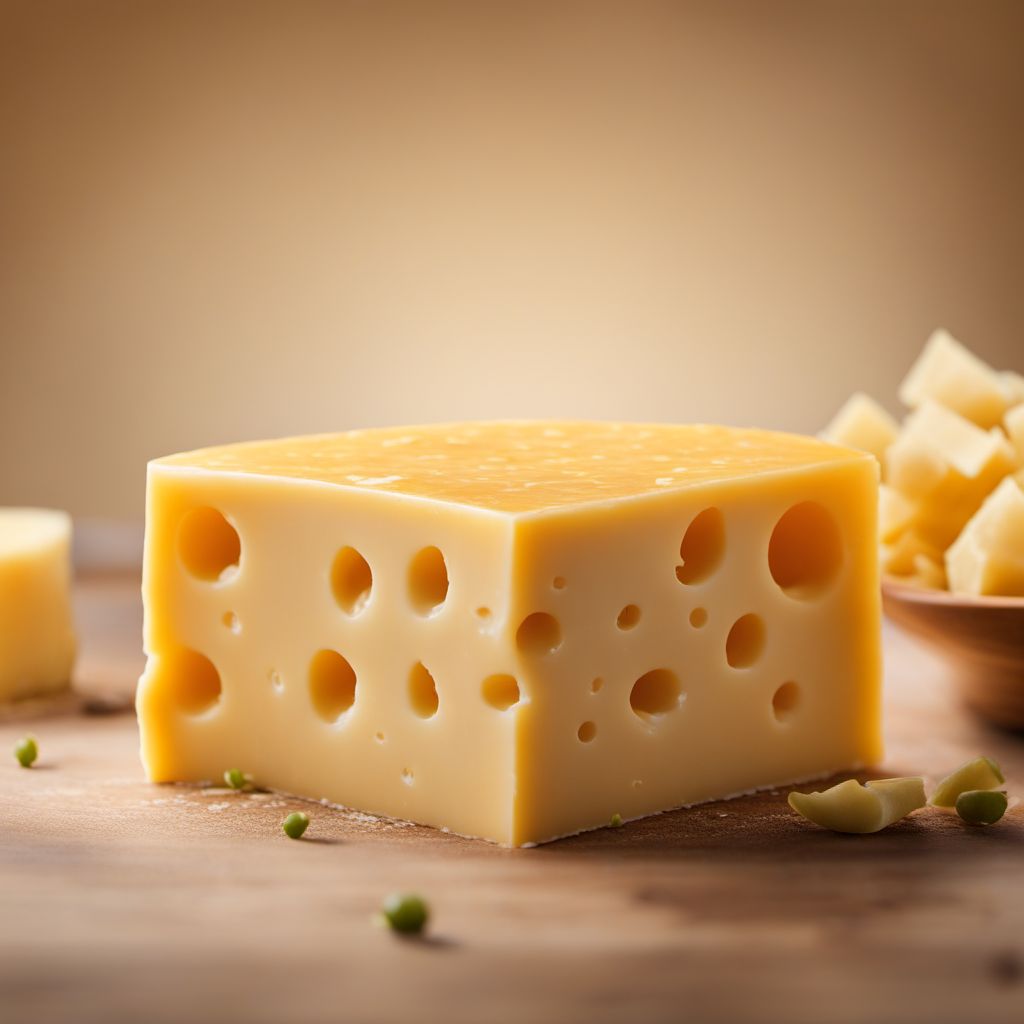
Ingredient
Hard cheese (cheddar, emmental type)
Aged Delights: Exploring the World of Hard Cheeses
Hard cheese, like cheddar and Emmental, is characterized by its firm and dense texture, which allows for easy slicing and grating. Cheddar, with its pale yellow color and crumbly texture, offers a sharp and tangy flavor profile, while Emmental, known for its distinctive holes and pale yellow interior, boasts a nutty and slightly sweet taste. Both cheeses have a rich and creamy mouthfeel, making them perfect for melting or enjoying on their own.
Origins and history
Cheddar cheese originated in the English village of Cheddar in the 12th century and has since become one of the most popular and widely consumed cheeses worldwide. Emmental, on the other hand, hails from Switzerland and has a history dating back to the 13th century. Both cheeses have deep cultural and historical significance in their respective regions, with cheddar being a staple in British cuisine and Emmental being a key ingredient in Swiss fondue.
Nutritional information
Hard cheeses like cheddar and Emmental are rich in protein and calcium, essential for maintaining strong bones and teeth. They also provide a good amount of vitamin A and B12. However, due to their high fat content, they should be consumed in moderation. A 1-ounce serving of cheddar cheese contains approximately 115 calories.
Allergens
Hard cheeses like cheddar and Emmental are typically made from cow's milk and may contain lactose, making them unsuitable for individuals with lactose intolerance or milk allergies.
How to select
When selecting hard cheeses, look for those with a firm texture and a well-aged appearance. Avoid cheeses with any signs of mold or excessive moisture. Opt for cheeses that have been properly stored and have a rich, golden color.
Storage recommendations
To maintain the freshness and quality of hard cheeses, store them in the refrigerator in airtight containers or wrapped tightly in wax paper or plastic wrap. This will help prevent moisture loss and the absorption of unwanted odors.
How to produce
Producing hard cheeses like cheddar and Emmental requires specialized equipment and knowledge. It is best left to professional cheese makers. However, adventurous home cooks can try their hand at making simpler hard cheeses like paneer or queso blanco.
Preparation tips
Hard cheeses like cheddar and Emmental can be enjoyed in various ways. They can be grated and used as a topping for pasta dishes or salads, melted into a gooey fondue, or simply enjoyed on a cheese board with fruits and crackers. When using in recipes, it is best to bring the cheese to room temperature before incorporating it to ensure even melting and blending.
Culinary uses
Hard cheeses like cheddar and Emmental are incredibly versatile and can be used in a wide range of dishes. They are commonly used in sandwiches, burgers, macaroni and cheese, quiches, and omelets. They also pair well with fruits, such as apples and pears, and are often enjoyed on cheese platters or charcuterie boards.
Availability
Hard cheeses like cheddar and Emmental are commonly available in most regions and can be found in grocery stores, supermarkets, and specialty cheese shops.
More ingredients from this category » Browse all

Cheese, cacio di fossa
The Hidden Gem of Italian Cheeses: Cacio di Fossa

Cheese, aged graviera
Savory Greek Delight

Cheese, hoch ybrig
The Alpine Delight: Unveiling the Richness of Hoch Ybrig Cheese

Cheese, majorero
Majorero: The Flavorful Cheese from the Canary Islands

Cheese, pecorino toscano
The Quintessential Tuscan Cheese: Pecorino Toscano

Cheese, canestrato pugliese
Canestrato Pugliese: A Taste of Puglia's Rich Cheese Heritage

Cheese, evora
Evora: A Portuguese Delight

Cheese, montasio
The Alpine Delight: Exploring the Richness of Montasio Cheese

Cheese, leyden
The Dutch Delight: Unveiling the Savory Secrets of Leyden Cheese

Cheese, gruyere
Gruyere: The Quintessential Swiss Cheese

Cheese, cheddar
"The King of Cheeses: Unveiling the Richness of Cheddar"

Cheese, kefalotyri
The Bold Greek Delight
Recipes using Hard cheese (cheddar, emmental type) » Browse all

Blagdanska Pogača Luciščak
Festive Delight: Luciščak Holiday Bread

Henan-style Cheese Scone
Savory Henan Cheese Delight

Virov'tički Krumpir Kolač with a Twist
Savory Croatian Potato Cake: A Delightful Twist on Tradition

Tajin Mahshi with Swiss Twist
Swiss-inspired Stuffed Tajin Delight

Northern European Style Beef and Mushroom Lasagne
Hearty Beef and Mushroom Lasagne: A Northern European Delight

Cauliflower with Ham and Cheese Bake
Savory Croatian Cauliflower Delight

Maltese Stuffed Bread
Savor the Flavors of Malta: Maltese Stuffed Bread

Cheesy Dumplings
Savory Delights: Cheesy Dumplings from the Heart of Austria

Lower Saxon Waffles
Savory Delights: Lower Saxon Waffles with a Twist

Rudarska Greblica - Croatian Miners' Pie
Savory Delight: Rustic Croatian Miners' Pie

Dutch Jachtschotel Recipe
Hearty Hunter's Delight: Dutch Jachtschotel

German-style Savory Pancakes with Herbs and Cheese
Herb-infused Flädle: A German Delight of Savory Pancakes